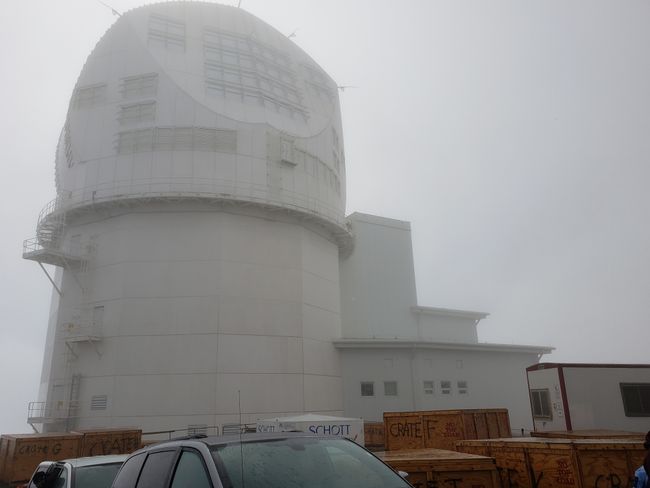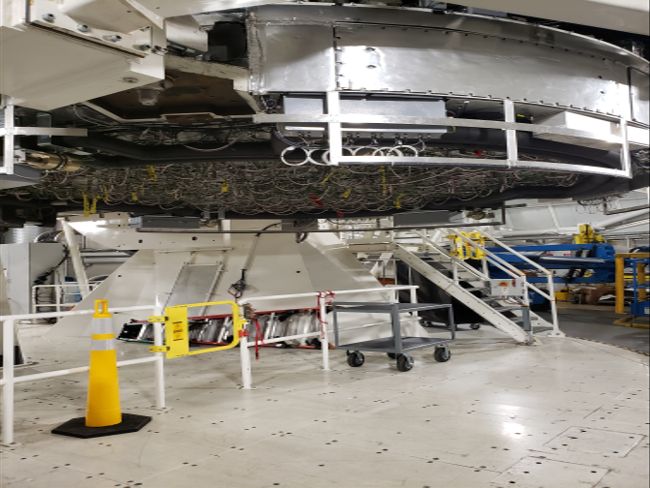Welcome to DU!
The truly grassroots left-of-center political community where regular people, not algorithms, drive the discussions and set the standards.
Join the community:
Create a free account
Support DU (and get rid of ads!):
Become a Star Member
Latest Breaking News
General Discussion
The DU Lounge
All Forums
Issue Forums
Culture Forums
Alliance Forums
Region Forums
Support Forums
Help & Search
Science
Related: About this forumInside the world's largest sun-spotting telescope
By Nola Taylor Redd 6 hours ago
A tour of the Daniel K. Inoye Solar Telescope, the world’s largest sun-spotting telescope.

The closed dome of the Daniel K. Inouye Solar Telescope
(Image: © NSO/NSF/AURA)
Perched atop the mountain Haleakalā on the island of Maui in Hawaii, the National Science Foundation's Daniel K. Inouye Solar Telescope stares up toward the sun.
The telescope, nicknamed DKIST, was scheduled to open in the summer of 2020 atop the mountain's summit, which has long been lauded for its incredible views of the sun, with tourists flocking to the peak to view incredible sunsets. The mountain's name is actually Hawaiian for 'house of the sun,' making it a fitting place for the world's largest solar telescope.
In January 2020, Space.com visited the telescope, named for the Hawaiian senator who served for nearly 50 years.

A look at the 76-foot telescope. The primary mirror sits above the metallic bottom surface. Near the top is the heat sink assembly that redirects most of the heat from the sunlight.
A look at the 76-foot telescope. The primary mirror sits above the metallic bottom surface. Near the top is the heat sink assembly that redirects most of the heat from the sunlight. (Image credit: NSO/NSF/AURA)
Safety and medical equipment are scattered through the high-altitude observatory.
Safety and medical equipment are scattered through the high-altitude observatory. (Image credit: NSO/NSF/AURA)
On the back wall of the Coudé Laboratory sits one of the mirrors responsible for redirecting light from the telescope.
On the back wall of the Coudé Laboratory sits one of the mirrors responsible for redirecting light from the telescope. (Image credit: NSO/NSF/AURA)
A closeup of the opening that allows sunlight to pass from the telescope to the lab.
A closeup of the opening that allows sunlight to pass from the telescope to the lab. (Image credit: NSO/NSF/AURA)
A look at the cleanroom laboratory through a glass window.
A look at the cleanroom laboratory through a glass window. (Image credit: NSO/NSF/AURA)
The rotating track on the floor allows the telescope to turn as the sun moves across the sky.
The rotating track on the floor allows the telescope to turn as the sun moves across the sky. (Image credit: NSO/NSF/AURA)
A circle in the dome, closed in this image, will allow the telescope to stare at the sun.
A circle in the dome, closed in this image, will allow the telescope to stare at the sun. (Image credit: NSO/NSF/AURA)
The underside of the primary mirror contains 120 actuators that keep it properly aligned.
The underside of the primary mirror contains 120 actuators that keep it properly aligned. (Image credit: NSO/NSF/AURA)
The author stands in front of the enormous solar telescope.
The author stands in front of the enormous solar telescope. (Image credit: NSO/NSF/AURA)
A straight-up look at the telescope towards the arm, where the temporary heat sink sits above the mirror.
A straight-up look at the telescope towards the arm, where the temporary heat sink sits above the mirror. (Image credit: NSO/NSF/AURA)
Work in progress
Because the telescope was still under construction during this visit, all visitors were required to don bright yellow clothing and a hard hat. But even once the observatory is complete, it will remain a potentially hazardous place to visit. With an altitude just over 10,000 feet (3,050 meters), the observatory sits above much of the Earth's atmosphere. The high altitude can affect visitors, and oxygen equipment and other health monitors were visible throughout the facility. High altitudes can cause shortness of breath, weakness, nausea and other symptoms, an issue that the group was reminded of when one visitor had to be taken to the hospital mid-visit.
More:
https://www.space.com/inoye-solar-sun-telescope-hawaii-tour.html
InfoView thread info, including edit history
TrashPut this thread in your Trash Can (My DU » Trash Can)
BookmarkAdd this thread to your Bookmarks (My DU » Bookmarks)
4 replies, 472 views
ShareGet links to this post and/or share on social media
AlertAlert this post for a rule violation
PowersThere are no powers you can use on this post
EditCannot edit other people's posts
ReplyReply to this post
EditCannot edit other people's posts
Rec (3)
ReplyReply to this post
4 replies
 = new reply since forum marked as read
Highlight:
NoneDon't highlight anything
5 newestHighlight 5 most recent replies
= new reply since forum marked as read
Highlight:
NoneDon't highlight anything
5 newestHighlight 5 most recent replies
Inside the world's largest sun-spotting telescope (Original Post)
Judi Lynn
May 2020
OP
And here I was patting myself on the back for buying a pair of Sunoculars. nt
eppur_se_muova
May 2020
#1
eppur_se_muova
(36,259 posts)1. And here I was patting myself on the back for buying a pair of Sunoculars. nt

mbusby
(823 posts)2. Mt. Evans...
...near Denver, Colorado is over 14,000 feet and you can drive up to the top of it in your car. It has the highest road in the western hemisphere. We drove our van to the top and climbed up another 200 feet to very top. Needless to say, the air is thin.
DavidDvorkin
(19,473 posts)3. And cold.
abqtommy
(14,118 posts)4. Cool! Used to live fairly close to Mt. Palomar in SoCal and visited the observatory there more
than once. I was always impressed and still am...